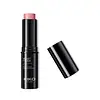What's inside
What's inside
 Key Ingredients
Key Ingredients

 Benefits
Benefits

 Concerns
Concerns

 Ingredients Side-by-side
Ingredients Side-by-side

Isononyl Isononanoate
EmollientMica
Cosmetic ColorantPolyethylene
AbrasiveSynthetic Wax
AbrasiveNeopentyl Glycol Dicaprylate/Dicaprate
EmollientPolymethylsilsesquioxane
Talc
AbrasiveZinc Stearate
Cosmetic ColorantSilica
AbrasiveDimethicone
EmollientEthylene Brassylate
MaskingPentaerythrityl Tetra-Di-T-Butyl Hydroxyhydrocinnamate
AntioxidantPlukenetia Volubilis Seed Oil
EmollientPistacia Vera Seed Oil
Skin ConditioningHydrogenated Vegetable Oil
EmollientTocopherol
AntioxidantBHT
AntioxidantTin Oxide
AbrasiveTitanium Dioxide
Cosmetic ColorantCI 77491
Cosmetic ColorantCI 15850
Cosmetic ColorantCI 19140
Cosmetic ColorantCI 45410
Cosmetic ColorantCI 73360
Cosmetic ColorantIsononyl Isononanoate, Mica, Polyethylene, Synthetic Wax, Neopentyl Glycol Dicaprylate/Dicaprate, Polymethylsilsesquioxane, Talc, Zinc Stearate, Silica, Dimethicone, Ethylene Brassylate, Pentaerythrityl Tetra-Di-T-Butyl Hydroxyhydrocinnamate, Plukenetia Volubilis Seed Oil, Pistacia Vera Seed Oil, Hydrogenated Vegetable Oil, Tocopherol, BHT, Tin Oxide, Titanium Dioxide, CI 77491, CI 15850, CI 19140, CI 45410, CI 73360
Ricinus Communis Seed Oil
MaskingPersea Gratissima Oil
Skin ConditioningEthylhexyl Palmitate
EmollientHelianthus Annuus Seed Wax
Skin ConditioningCandelilla Cera
EmollientC12-15 Alkyl Benzoate
AntimicrobialIsononyl Isononanoate
EmollientSilica
AbrasiveParfum
MaskingCitrus Aurantium Dulcis Peel Wax
Skin ConditioningMangifera Indica Seed Butter
Skin ConditioningPrunus Armeniaca Kernel Oil
MaskingTocopheryl Acetate
AntioxidantHydrogenated Vegetable Oil
EmollientMica
Cosmetic ColorantStearalkonium Hectorite
Gel FormingIsopropyl Myristate
EmollientPolyhydroxystearic Acid
EmulsifyingBis-Stearyl Dimethicone
EmollientIsopropyl Titanium Triisostearate
EmollientSynthetic Fluorphlogopite
Tin Oxide
AbrasivePalmitic Acid
EmollientLimonene
PerfumingLinalool
PerfumingCI 77891
Cosmetic ColorantCI 77492
Cosmetic ColorantCI 15850
Cosmetic ColorantCI 73360
Cosmetic ColorantCI 19140
Cosmetic ColorantRicinus Communis Seed Oil, Persea Gratissima Oil, Ethylhexyl Palmitate, Helianthus Annuus Seed Wax, Candelilla Cera, C12-15 Alkyl Benzoate, Isononyl Isononanoate, Silica, Parfum, Citrus Aurantium Dulcis Peel Wax, Mangifera Indica Seed Butter, Prunus Armeniaca Kernel Oil, Tocopheryl Acetate, Hydrogenated Vegetable Oil, Mica, Stearalkonium Hectorite, Isopropyl Myristate, Polyhydroxystearic Acid, Bis-Stearyl Dimethicone, Isopropyl Titanium Triisostearate, Synthetic Fluorphlogopite, Tin Oxide, Palmitic Acid, Limonene, Linalool, CI 77891, CI 77492, CI 15850, CI 73360, CI 19140
 Reviews
Reviews

Ingredients Explained
These ingredients are found in both products.
Ingredients higher up in an ingredient list are typically present in a larger amount.
Ci 15850 is the pigment color red. It is an azo dye and created synthetically.
Azo dyes need to be thoroughly purified before use. This allows them to be more stable and longer-lasting.
This ingredient is common in foundations, lipsticks, and blushes. This color is described as brown/orangey red.
It has many secondary names such as Red 6 and Red 7. According to a manufacturer, Red 6 usually contains aluminum.
Learn more about CI 15850CI 19140 is also known as Tartrazine. Tartrazine is a synthetic dye used in cosmetics, foods, and medicine to add a yellow color.
Tartrazine is created from petroleum and is water-soluble.
Some people may experience allergies from this dye, especially asthmatics and those with an aspirin intolerance.
Learn more about CI 19140Ci 73360 is a synthetic red-pink dye.
Hydrogenated Vegetable Oil is created by adding hydrogen to vegetable oil in order to give it more stability. This process also raises the melting point of vegetable oil. In cosmetics, it is an emollient.
Emollients help soothe and soften the skin. They do this by creating a protective film on your skin. This barrier helps trap moisture and keeps your skin hydrated. Emollients may be effective at treating dry or itchy skin.
The term "Hydrogenated Vegetable Oil" is an umbrella term and can refer to a variety of vegetable oils and blends of: sunflower oil, soybean oil, olive oil, coconut oil, palm oil, and more.
Due to the differences in vegetables, the benefits may vary.
Learn more about Hydrogenated Vegetable OilIsononyl Isononanoate is a synthetic skin-conditioner and texture enhancer. It is created from nonanoic acid, a fatty acid found in cocoa and lavender oil.
As an emollient, Isononyl Isononanoate helps keep your skin soft and smooth. This is because emollients create a barrier on the skin to trap moisture in.
Isononyl Isononanoate helps give products a velvet feel and improves spreadability.
Learn more about Isononyl IsononanoateMica is a naturally occurring mineral used to add shimmer and color in cosmetics. It can also help improve the texture of a product or give it an opaque, white/silver color.
Serecite is the name for very fine but ragged grains of mica.
This ingredient is often coated with metal oxides like titanium dioxide. Trace amounts of heavy metals may be found in mica, but these metals are not harmful in our personal products.
Mica has been used since prehistoric times throughout the world. Ancient Egyptian, Indian, Greek, Roman, Aztec, and Chinese civilizations have used mica.
Learn more about MicaSilica, also known as silicon dioxide, is a naturally occurring mineral. It is used as a fine, spherical, and porous powder in cosmetics.
Though it has exfoliant properties, the function of silica varies depending on the product.
The unique structure of silica enhances the spreadability and adds smoothness, making it a great texture enhancer.
It is also used as an active carrier, emulsifier, and mattifier due to its ability to absorb excess oil.
In some products, tiny microneedles called spicules are made from silica or hydrolyzed sponge. When you rub them in, they lightly polish away dead skin layers and enhance the penetration of active ingredients.
Learn more about SilicaTin Oxide is an inorganic oxide used to add opacity and volume to a product. In nature, it is already found in mineral form. The main ore of tin is an opaque and shiny mineral called casseterite.
Tin Oxide helps remove translucency in a product, or make it more opaque. Besides adding opacity, tin oxide is used for bulking to add volume.